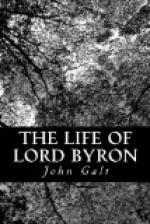“September 22, 18 16.—Left Thun in a boat, which carried us the length of the lake in three hours. The lake small, but the banks fine; rocks down to the water’s edge: landed at Newhouse; passed Interlachen; entered upon a range of scenes beyond all description or previous conception; passed a rock bearing an inscription; two brothers, one murdered the other; just the place for it. After a variety of windings, came to an enormous rock; arrived at the foot of the mountain (the Jungfrau) glaciers; torrents, one of these nine hundred feet, visible descent; lodge at the curate’s; set out to see the valley; heard an avalanche fall like thunder; glaciers; enormous storm comes on thunder and lightning and hail, all in perfection and beautiful. The torrent is in shape, curving over the rock, like the tail of the white horse streaming in the wind, just as might be conceived would be that of the pale horse on which Death is mounted in the Apocalypse: it is neither mist nor water, but a something between both; its immense height gives a wave, a curve, a spreading here, a condensation there, wonderful, indescribable
“September 23.—Ascent of the Wingren, the dent d’argent shining like truth on one side, on the other the clouds rose from the opposite valley, curling up perpendicular precipices like the foam of the ocean of hell during a spring-tide. It was white and sulphury, and immeasurably deep in appearance; the side we ascended was of course not of so precipitous a nature; but on arriving at the summit, we looked down on the other side upon a boiling sea of cloud dashing against the crag on which we stood. Arrived at the Greenderwold, mounted and rode to the higher glacier, twilight, but distinct, very fine; glacier like a frozen hurricane; starlight beautiful; the whole of the day was fine, and, in point of weather, as the day in which Paradise was made. Passed whole woods of withered pines, all withered, trunks stripped and lifeless, done by a single winter.”
Undoubtedly in these brief and abrupt but masterly touches, hints for the scenery of Manfred may be discerned, but I can perceive nothing in them which bears the least likelihood to their having influenced the conception of that sublime work.
There has always been from the first publication of Manfred, a strange misapprehension with respect to it in the public mind. The whole poem has been misunderstood, and the odious supposition that ascribes the fearful mystery and remorse of a hero to a foul passion for his sister, is probably one of those coarse imaginations which have grown out of the calumnies and accusations heaped upon the author. How can it have happened that none of the critics have noticed that the story is derived from the human sacrifices supposed to have been in use among the students of the black art?
Manfred is represented as being actuated by an insatiable curiosity— a passion to know the forbidden secrets of the world. The scene opens with him at his midnight studies—his lamp is almost burned out—and he has been searching for knowledge and has not found it, but only that




